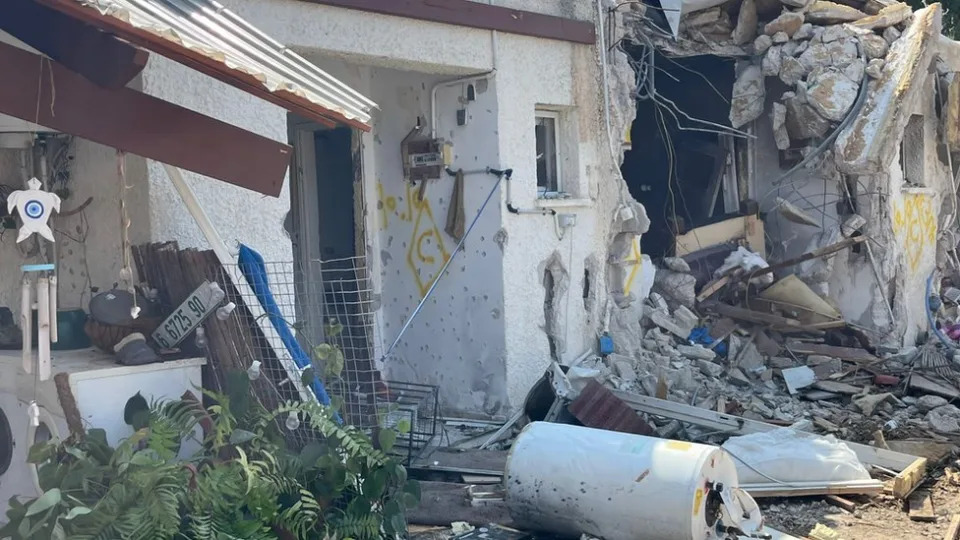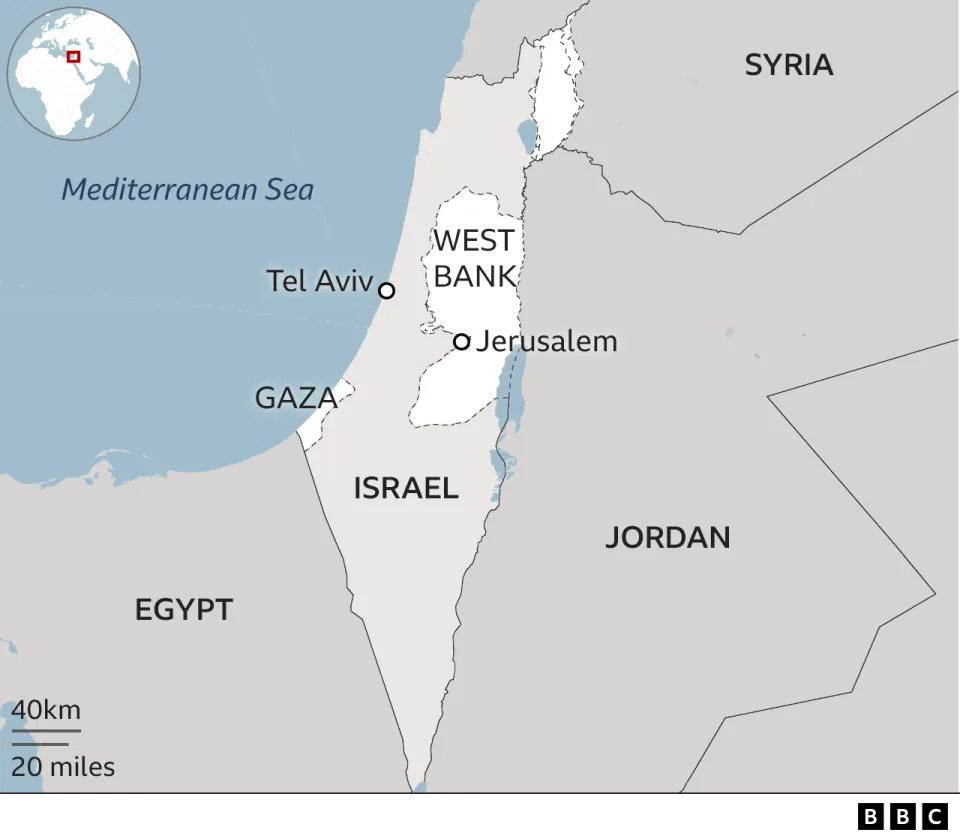Hamas gunmen launched an unprecedented attack on Israel from the Gaza Strip on 7 October, killing more than 1,400 people and taking more than 220 hostages.
Gaza's Hamas-run health ministry says more than 7,000 people have been killed in the territory since Israel launched retaliatory air strikes, and a ground offensive is expected.
What is happening in the Gaza Strip?
Hospitals in Gaza are admitting emergency cases only as fuel runs out, according to the World Health Organization.
The UN's agency for Palestinian refugees, Unrwa, say is has significantly reduced its operations because it has almost exhausted its fuel reserves.
Small quantities of fuel retrieved from existing reserves are being used to maintain the water supply in the south of Gaza. However, they will run out soon.
An Israel Defense Forces (IDF) spokesman said Gaza still had fuel but "Hamas prefers to have all of the fuel for its warfighting capabilities, leaving civilians without it".
More than 70 aid lorries have now entered the territory through the Rafah crossing with Egypt since Israel imposed a "complete siege" at the start of the conflict.
However, these have provided only a fraction of the needs of people in Gaza. Unrwa called it "a drop in the ocean of overwhelming needs". About 500 lorries were allowed into Gaza every day before the start of the war.
An estimated 1.4 million people in Gaza have been displaced, according to the UN.
Hundreds of thousands moved from the north of the territory to the south, after being told by the Israeli military to leave for their own safety.
The WHO has also warned that it is "almost impossible" for patients in hospitals in northern Gaza to be evacuated.

The southern city of Khan Younis, normally home to 400,000 people, has seen its population increase to about 1.2 million. Many families are sharing homes, or sleeping in tents.
However, Israel has continued to carry out strikes on what it says are Hamas military targets in southern Gaza.
Some of those who initially fled the north of Gaza are now returning because the situation in the south is so bad, the UN has said.
The UN's regional humanitarian chief has said: "Nowhere is safe in Gaza."
US Secretary of State Antony Blinken has suggested a temporary ceasefire to allow more aid to enter Gaza, and and EU leaders are also expected to call for one.
Will Israel invade Gaza?
Israeli Prime Minister Benjamin Netanyahu said on Wednesday: "We have set two goals for this war: to eliminate Hamas by destroying its military and governing abilities, and to do everything possible to bring our captives home."
"All Hamas terrorists are dead men walking - above ground, below ground, outside Gaza."
Mr Netanyahu said Israel would launch a ground incursion, but did not detail when it would start.
On Thursday morning, the IDF said it had carried out a "targeted raid" on defensive positions in northern Gaza with tanks and armoured bulldozers. It said this was "part of preparations for the next stages of combat".
Israeli forces have carried at least two other raids into Gaza since the conflict started. In one, on 22 October, one soldier was killed and three were injured.
The IDF has massed tens of thousands of soldiers along the territory's perimeter fence, along with tanks and artillery. It has activated some 300,000 reservists, alongside its standing force of 160,000.
Hamas is thought to have about 25,000 people in its military wing, the Izzedine al-Qassam Brigades.
One of Israel's main targets is Hamas's vast labyrinth of underground tunnels, which contain bunkers for leaders and operational headquarters.

Hamas has previously claimed the tunnels stretch for 500km (310 miles). Many have entrances hidden within houses, mosques, schools and other public buildings.
Israel's troops are likely to avoid going into tunnels unless they have to, instead using explosives to destroy them.
A major challenge for the Israeli troops will be close-quarters fighting in densely populated urban areas. It is thought that Hamas will lay booby traps and improvised explosive devices at entry points such as doorways, and along narrow streets.
What is Hamas and what does it want?
Hamas is a Palestinian group which has ruled the Gaza Strip since 2007. The group is sworn to Israel's destruction and wants to replace it with an Islamic state.
Hamas has fought several wars with Israel since it took power. It has fired - or allowed other groups to fire - thousands of rockets into Israel, and has carried out other deadly attacks.
In response, Israel has repeatedly attacked Hamas with air strikes. In 2008 and 2014, it also sent troops into Gaza.
Together with Egypt, Israel has blockaded the Gaza Strip since 2007 for what it describes as security reasons.
Hamas - or in some cases its military wing, the Izzedine al-Qassam Brigades - has been designated a terrorist group by Israel, the United States, the European Union and the UK, as well as other powers.
Iran backs the group, providing it with funding, weapons and training.
What was the Hamas attack on Israel?

On 7 October, hundreds of Hamas gunmen crossed from the Gaza Strip into southern Israel by breaking through the heavily-fortified perimeter fence, landing by sea, and using paragliders.
It was the most serious cross-border attack Israel has faced in more than a generation, according to the BBC's international editor Jeremy Bowen.
The gunmen killed 1,400 people, most of them civilians, in a series of raids on military posts, kibbutzim and a music festival, and took hostages back into Gaza.
Given the resources of Israel's security services, it was astounding that the attack by Hamas was not anticipated, the BBC's security correspondent Frank Gardner says.
It came at a time of soaring Israeli-Palestinian tensions.
This year has been the deadliest on record for Palestinians who live in the Israeli-occupied West Bank, which could have motivated Hamas to strike Israel.
Hamas might also have been seeking to score a significant propaganda victory to boost its popularity among ordinary Palestinians.
The capture of Israeli hostages is thought to be designed to pressure Israel to free some of the estimated 4,500 Palestinians held in Israeli prisons.
The Israeli military believes 224 people are still being held in Gaza.
They include 20 children and at least 10 people aged over 60. Soldiers were also taken hostage.
What is the Gaza Strip and who lives there?
The Gaza Strip is a 41km (25-mile) long and 10km-wide territory located between Israel, Egypt and the Mediterranean Sea.

Originally occupied by Egypt, Gaza was captured by Israel during the 1967 Six Day war.
Israel withdrew its troops and around 7,000 settlers from the territory in 2005.
It is home to 2.23 million people and has one of the highest population densities in the world.
Just over 75% of Gaza's population - some 1.7 million people - are registered refugees or descendants of refugees, according to the UN. More than 500,000 of them live in eight crowded camps located across the Strip.
Israel controls the air space over Gaza and its shoreline, and has strictly controlled the movement of people and goods.
What is Palestine?
The West Bank and Gaza, which are known as the Palestinian territories, as well as East Jerusalem and Israel all formed part of a land known as Palestine from Roman times until the mid-20th Century.
These were also the lands of Jewish kingdoms in the Bible, and are seen by many Jews as their ancient homeland.
Israel was declared a state in 1948, though the land is still referred to as Palestine by those who do not recognise Israel's right to exist.
Palestinians also use the name Palestine as an umbrella term for the West Bank, Gaza and East Jerusalem.
The Palestinian president is Mahmoud Abbas, also known as Abu Mazen. He is based in the West Bank, which is under Israeli occupation.
He has been the leader of the Palestinian Authority (PA) since 2005, and represents the Fatah political party, a bitter rival of Hamas.


